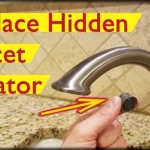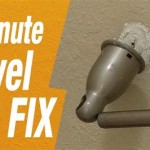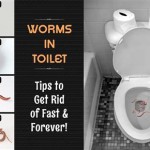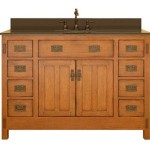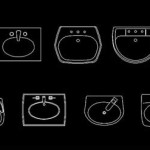How To Stop Drain Flies In Your Bathroom
Drain flies, also known as moth flies, sewer flies, or filter flies, are small, fuzzy insects that thrive in moist environments rich in organic matter. Their presence in a bathroom, while unsettling, is a common problem. These flies are not typically a health hazard, as they do not bite or transmit diseases. However, their ability to breed prolifically in drains and sewers makes them a nuisance, and their presence indicates unsanitary conditions within the plumbing system.
Understanding the lifecycle and habits of drain flies is crucial for effective control and prevention. These flies lay their eggs in the gelatinous film that accumulates on the inner surfaces of drains, pipes, and septic tanks. The larvae feed on this organic matter, contributing to its decomposition. The entire lifecycle, from egg to adult, can be completed in as little as two weeks, allowing for rapid population growth if left unchecked. Adult drain flies are weak fliers, often seen hopping or fluttering near their breeding sites. Eliminating these breeding sites is the key to permanently solving a drain fly infestation.
Identifying and Locating the Source
The first step in eliminating drain flies is accurately identifying them. They are typically small, about 1/8 to 1/4 inch in length, with a fuzzy, moth-like appearance. Their wings are held roof-like over their bodies when at rest. Unlike fruit flies, which are attracted to overripe fruits and vegetables, drain flies primarily congregate around drains, sinks, showers, and toilets.
Locating the specific drain or area where the flies are breeding is essential. A simple method to pinpoint the source is to use the "tape test." Cover the drain opening with a piece of clear tape, sticky-side down, leaving a small portion of the drain exposed. Avoid completely sealing the drain, as this will prevent flies from emerging. Leave the tape in place overnight. If drain flies are breeding in that drain, they will get stuck on the tape as they emerge during the night. Repeat this process on all drains in the bathroom to identify the primary source of the infestation. This test is most effective when the drains are not in use overnight.
In addition to the tape test, visually inspect the drains and surrounding areas. Look for signs of organic buildup, such as a slimy or gelatinous film on the drain walls. Examine the area around the drain opening for any cracks or crevices where organic matter may accumulate. Pay close attention to overflow drains in sinks and tubs, as these can be easily overlooked breeding grounds. If the tape test is inconclusive, consider inspecting the drainpipes under the sink and shower for leaks or damaged sections that may be contributing to moisture and organic buildup.
Cleaning and Treating Infested Drains
Once the source of the drain flies has been identified, the next step is to thoroughly clean and treat the infested drain and surrounding areas. This process involves removing the organic matter that serves as a breeding ground for the flies and implementing preventative measures to discourage future infestations.
Begin by physically cleaning the drain with a drain brush or pipe cleaner. These tools can effectively scrub the inner walls of the drain to remove the accumulated slime and debris. Focus on areas where the organic matter is most concentrated, particularly around the drain opening and the first few inches of the drainpipe. For larger drains, a flexible auger or snake can be used to reach deeper into the pipe and remove stubborn blockages.
After the physical cleaning, consider using a drain cleaner specifically formulated to dissolve organic matter. Enzyme-based drain cleaners are generally preferred over chemical drain cleaners, as they are less harmful to the environment and plumbing systems. Enzyme cleaners work by breaking down the organic matter into smaller, more soluble molecules that can be easily flushed away. Follow the manufacturer's instructions carefully when using any drain cleaner. Avoid using harsh chemical drain cleaners, such as those containing bleach or strong acids, as these can damage pipes and pose health risks. These chemicals do not effectively remove the organic buildup and can simply create a temporary solution.
Another effective method for treating infested drains is to use a mixture of baking soda, vinegar, and hot water. Pour a cup of baking soda down the drain, followed by a cup of vinegar. Allow the mixture to fizz for about 30 minutes, then flush with hot water. This combination can help to loosen and remove organic matter, as well as neutralize odors. Repeat this process several times a week to maintain a clean drain.
Hot water alone can also be effective in flushing out organic matter and killing drain fly larvae. Pour a large pot of boiling water down the drain several times a day for several days. Be cautious when using boiling water, as it can damage some types of pipes, particularly PVC pipes. Check the pipe material before using boiling water and avoid using it on older, fragile pipes.
It is crucial to repeat the cleaning and treatment process regularly to prevent drain flies from returning. Even after the initial infestation has been eliminated, periodic cleaning will help to maintain a clean drain environment and discourage the buildup of organic matter that attracts drain flies.
Preventative Measures and Long-Term Solutions
Preventing drain flies from returning requires implementing long-term solutions that address the underlying causes of the infestation. This includes maintaining a clean bathroom environment, preventing water leaks, and regularly cleaning drains to prevent the buildup of organic matter.
Regularly cleaning the bathroom, including scrubbing the sink, shower, and toilet, will help to minimize the amount of organic matter available for drain flies to breed. Pay particular attention to areas where water tends to accumulate, such as around the drain openings and shower corners. Use a disinfectant cleaner to kill bacteria and fungi that can contribute to the buildup of slime and debris.
Addressing water leaks promptly is essential for preventing drain fly infestations. Leaky faucets, pipes, or showerheads create a moist environment that is conducive to the growth of organic matter. Repair any leaks as soon as they are detected to eliminate the moisture source that attracts drain flies. Inspect the plumbing regularly for signs of leaks, such as water stains, mold growth, or dampness. Check the seals around toilets and sinks to ensure that they are watertight.
Installing drain screens or stoppers in the drains can help to prevent hair and other debris from entering the pipes and contributing to the buildup of organic matter. These screens should be cleaned regularly to prevent them from becoming clogged. Consider using a drain strainer with a fine mesh to capture even small pieces of debris. Empty and clean the strainer frequently to maintain its effectiveness.
Regularly flushing drains with hot water and enzyme-based drain cleaners will help prevent the buildup of organic matter. Schedule regular drain cleaning as part of the bathroom maintenance routine. This can be done monthly or quarterly, depending on the frequency of drain use and the severity of the drain fly problem. Consistent drain maintenance will help to keep the drains clean and free of the organic matter that attracts drain flies.
In some cases, a professional plumber may be required to address more severe drain fly infestations. A plumber can inspect the plumbing system for hidden leaks, damaged pipes, or other issues that may be contributing to the problem. They can also use specialized equipment, such as hydro-jetting, to thoroughly clean the drains and remove stubborn blockages. This method uses high-pressure water to blast away organic matter and debris from the inside of the pipes. A plumber can also apply drain treatments that are more potent and effective than those available to the general public.
By understanding the lifecycle and habits of drain flies, identifying and eliminating their breeding sites, and implementing preventative measures, homeowners can effectively control and prevent these nuisance pests from infesting their bathrooms. Consistent cleaning, leak prevention, and regular drain maintenance are essential for maintaining a healthy and pest-free bathroom environment.

How To Get Rid Of Drain Flies 6 Expert Tips Truly Blog

How To Get Rid Of Drain Flies 6 Expert Tips Truly Blog

Magic Salt How To Get Rid Of Drain Flies Home Remedy

Drain Flies How To Get Rid Of Them Home Remedies In Bathroom Drainflies

4 Ways To Get Rid Of Drain Flies Wikihow

How To Get Rid Of Drain Flies At Home

How To Get Rid Of Drain Flies In One Week Ryan Old Plumbing

How To Get Rid Of Drain Flies Moth And Prevent An Infestation Pest Defence

How To Get Rid Of Drain Flies Green House Plumbing

How To Get Rid Of Drain Flies In Shower Kitchen Or Bathroom
Related Posts

